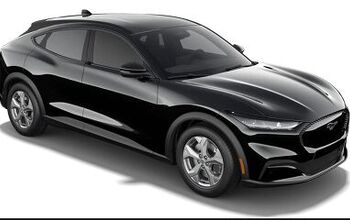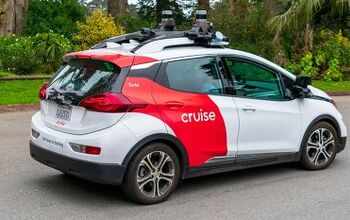Ace of Base: 2021 Ford E-Series Cutaway

No, despite appearances, we haven’t taken complete leave of our senses. At least not until our road tester starts telling us in excruciating detail about how he wants to see the Genesis reunion later this year.
On the pickup truck side of Ford’s showroom, the cheapest way into a rig powered by the burly 7.3-liter V8 is via an Ace of Base F-250. That vehicle bears a price of $33,705 plus $2,045 for the hairy-chested eight-pot. The E-Series starts at just $33,265 … and carries the 7.3L as standard equipment.
Yes, there is the small matter of there not being any sheet metal aft of the driver’s compartment. Surely you’re handy with the welder and a pair of tin snips, right?
Joking aside, it’s telling that the E-Series (née Econoline) is no longer offered as a panel van, indicating that the Glass House has gone all-in on the Transit as their option for commercial van customers. Note well: the E-Series isn’t worthy of the brand’s 10-speed automatic, making do with a six-cog box. The mighty 7.3L V8 still makes 468 lb-ft of torque but is detuned slightly to 350 horsepower compared to the Super Duty’s 430 ponies.
Surprisingly, the bean counters at Ford looked under some couch cushions and found a bit of change to give the E-Series its first interior restyle since the Jurassic era. Its steering wheel is now taken from a modern F-150 and not a truck from the ‘90s. Those all-important gauges are F-150-sourced as well, bringing a modern look to a rig that’s used the same dials for eons. Two other observations: those HVAC controls are the same ones found in my father’s 1995 Aerostar and that radio (you can’t call it infotainment) seems to show up in precisely zero other North American Ford products.
Air conditioning is standard equipment, which is a good thing because so are vinyl bucket seats. The floor is covered in hose-it-out material, as well. Perhaps surprisingly, one will find a tilt/telescope steering wheel (no cruise, though) and a pair of USB ports. That chrome bumper shown above is optional, too.
Are we odd for profiling this half-a-van in today’s Ace of Base? Are all the F1 teams sulky at Ferrari right now? Does our editor love Fox-bodied Mustangs? The answer to all these questions is a resounding “yes.” However, it amuses your author greatly that the lowly E-Series packs a 7.3L V8 as standard kit … even if it’s a bit breezy around back.
[Images: Ford]
Not every base model has aced it. The ones which have? They help make the automotive landscape a lot better. Any others you can think of, B&B? Let us know in the comments and feel free to eviscerate our selections.
The model above is shown with American options and priced in American Dollars. Your dealer may sell for less.

Matthew buys, sells, fixes, & races cars. As a human index of auto & auction knowledge, he is fond of making money and offering loud opinions.
More by Matthew Guy
Latest Car Reviews
Read moreLatest Product Reviews
Read moreRecent Comments
- MaintenanceCosts Nobody here seems to acknowledge that there are multiple use cases for cars.Some people spend all their time driving all over the country and need every mile and minute of time savings. ICE cars are better for them right now.Some people only drive locally and fly when they travel. For them, there's probably a range number that works, and they don't really need more. For the uses for which we use our EV, that would be around 150 miles. The other thing about a low range requirement is it can make 120V charging viable. If you don't drive more than an average of about 40 miles/day, you can probably get enough electrons through a wall outlet. We spent over two years charging our Bolt only through 120V, while our house was getting rebuilt, and never had an issue.Those are extremes. There are all sorts of use cases in between, which probably represent the majority of drivers. For some users, what's needed is more range. But I think for most users, what's needed is better charging. Retrofit apartment garages like Tim's with 240V outlets at every spot. Install more L3 chargers in supermarket parking lots and alongside gas stations. Make chargers that work like Tesla Superchargers as ubiquitous as gas stations, and EV charging will not be an issue for most users.
- MaintenanceCosts I don't have an opinion on whether any one plant unionizing is the right answer, but the employees sure need to have the right to organize. Unions or the credible threat of unionization are the only thing, history has proven, that can keep employers honest. Without it, we've seen over and over, the employers have complete power over the workers and feel free to exploit the workers however they see fit. (And don't tell me "oh, the workers can just leave" - in an oligopolistic industry, working conditions quickly converge, and there's not another employer right around the corner.)
- Kjhkjlhkjhkljh kljhjkhjklhkjh [h3]Wake me up when it is a 1989 635Csi with a M88/3[/h3]
- BrandX "I can charge using the 240V outlets, sure, but it’s slow."No it's not. That's what all home chargers use - 240V.
- Jalop1991 does the odometer represent itself in an analog fashion? Will the numbers roll slowly and stop wherever, or do they just blink to the next number like any old boring modern car?

































Comments
Join the conversation
Am I the only one who cringes when an author uses "kit" in place of "equipment" in the same way I cringe when a mommy blogger says "hubby" ??
I have several relatives who live in the People's Democratic Republic of California and this is a subject best not brought up in conversation.